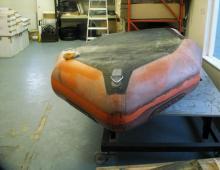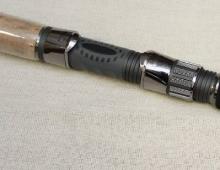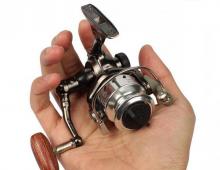Inflatable boats: selection criteria and popular rubber models for fishing
Many people who are fond of fishing have boats, and those who do not think about buying them. Any large store has a wide range of different types of inflatable boats. And here the question arises: how to choose from this variety? What is the essential difference between one and the other?
At first glance, it may seem that there is no difficulty in choosing, but not everything is so simple. Only experienced fishermen can take into account all the nuances when buying. Beginners should study this issue in more detail in order to buy a small boat specifically for their needs. And if you make the right choice, you can avoid problems with operation in the future, and care, transportation and other aspects will not be difficult.
Varieties of inflatable boats
There is a great variety of swimming facilities presented by various manufacturers and price categories. However, they differ not only in manufacturer or price.
There are many other criteria by which all similar products differ from each other:
- Number of seats(single, double, triple and so on). There are even boats designed for 10 or more places, but they are generally not considered as fishing boats.
- Material from which they are made. For this, mainly reinforced polyvinyl chloride (or just PVC), traditional rubber or expensive hipalon and neoprene are used.
- Size. Basically, the sizes range from 2 to 4 meters. The length of the boat, as a rule, directly depends on the number of seats.
- Bottom design. Many important nuances will depend on how it will depend: the ability to fish standing up (it is difficult to do without a hard bottom), stability at full speed, stability of the craft in high waves, safety. There are the following main types of structures:
- with soft bottom(difficult to keep balance while standing)
- slate(slani - special panels inserted into the floor),
- (form a rigid structure that provides stability at high speed and the possibility of installing more powerful engines),
- with hard bottom. They are kind of a hybrid. For them, the possibility of extension is often provided.
- The presence of a transom. The presence of a transom allows you to equip. This is especially important when fishing on the river, since you can’t swim far with oars when moving against the current.
pvc fabric
The most popular material is reinforced polyvinyl chloride. Recently, I have been replacing rubber products from the shelves with such PVC products.
This is not surprising, because they have a large number of advantages in comparison with them:
- reinforced PVC fabric is much stronger than rubberized fabric with the same thickness (due to higher density),
- ease of repair
- environmental friendliness,
- higher resistance to decay (no need to dry after use, not afraid of dampness during storage),
- all seams are more durable and do not deform in the heat.
rubberized fabric

The choice of motor for an inflatable boat
The possibility of installing a motor and its power are determined by the presence of a transom, the size of the vessel and its design features. For inflatable swimming facilities, 2 types of transoms are used: stationary and suspended.
The stationary transom is an inseparable part of the vessel. It is most often used on larger boats, and suspended is typical for small ones.
Any boat that has the ability to install a motor has recommendations for choosing the power of the motor. Therefore, you should pay attention to this and choose the right motor. So, if the motor is too powerful and, accordingly, heavy, then this can adversely affect not only the quality of the course, but also the very design of the craft. On the other hand, a motor that is too small in power will not make it possible to gain the desired speed, especially when loaded.
In turn, motors differ not only in manufacturer and power, but also in the type of energy carrier used. So, distinguish between gasoline and electric engines.
electric motor
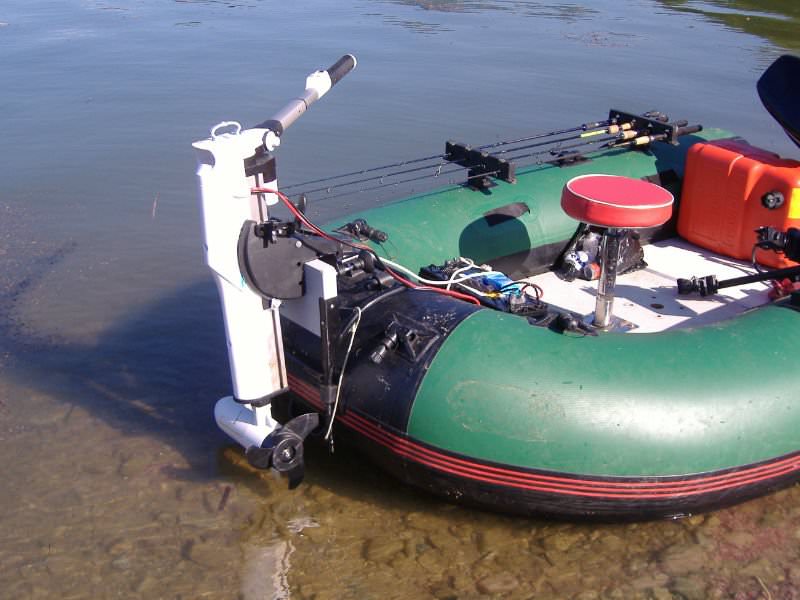
- propeller motor,
- adjustable rod, on which the motor itself is attached (adjusting the rod allows you to successfully go aground),
- steering tiller,
- control panel (for selecting speed and reverse),
- a clamp that allows you to securely fix the engine to the transom.
In addition, you need to buy a battery, which is not included.
Boat motors have been in great demand lately. This is due to the many positive qualities inherent in them:
- Price. An electric motor with a battery is much cheaper than a similar gasoline engine.
- Economy. Unlike a gasoline engine, it does not require constant and only needs to recharge the battery.
- Simplicity exploitation. Does not require preparation for storage, can be transported in any position (unlike four-stroke gasoline engines), no need for frequent lubrication, easier to repair.
- Weight and dimensions. Electric motors are much lighter than gasoline ones (often no more than 10 kg) and have smaller dimensions, which is a definite plus when transported by car.
- Noiseless running. This is a big plus for any angler.
- Ability to catch at low speed(trolling at 3 km/h).
- Confident walking in shallow water(due to the adjustable bar).
- Environmental friendliness. Electric motors are absolutely safe for the environment and can be used where gasoline is prohibited.
gasoline engine
Gasoline engines are still more common for small boats. Most fishermen prefer them as the main engine, and use the electric one as an auxiliary one.
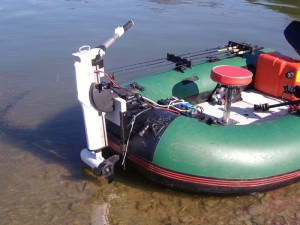 4-stroke gasoline engines consume less fuel
4-stroke gasoline engines consume less fuel There are 2 types of gasoline engines:
- push pull. It is much cheaper than a four-stroke and is easier to repair and maintain. But at the same time, difficulties arise with transportation - it must be transported and stored in one position, as indicated by the manufacturer (otherwise oil will leak).
- four stroke. Despite the higher cost, it is more economical (consumes less fuel). In addition, the motor resource of such engines is several times greater.
All gasoline outboard motors have a number of advantages over electric motors:
- much more powerful
- allow for greater speed
- make it possible to travel longer distances.
For 7 years of active passion for fishing, I have found dozens of ways to improve the bite. Here are the most effective ones:
- Biting activator. This pheromone additive lures fish the most in cold and warm water. Discussion of the Hungry Fish bite activator.
- Raise gear sensitivity. Read the appropriate manuals for the particular type of tackle.
- Lures based pheromones.
Models and cost
Let us now consider in more detail some models of inflatable boats, their characteristics and approximate cost.
- « Volga» is a series of inflatable rubber boats. It has both rowing models and models that allow you to install motors with a power of 2.5–3 hp. The number of seats is from 1 to 2. Depending on the model and configuration, the price for such products ranges from 5,500 to 12,500 rubles.
- « Vega". Boats made of reinforced PVC and rubberized fabric of the Yaroslavl plant are no less popular than the Volga. The Vega series includes the Vega 2, Vega 3, Vega 12 models with various configurations. They are distinguished by the presence or absence of an inflatable bottom, the possibility of installing a motor (2.5–3 hp), inflatable or hard seats. Let's look at each model in more detail in the following table.
| Brand | Weight | load capacity | Length | Width | Number of passengers | Price, rub.) |
| "Vega 2" | 17–20 kg | 300–320 kg | 250 cm | 115 cm | 2 | 8000–10000 |
| "Vega 3" | 25–33 kg | 400 kg | 300 cm | 135 cm | 3 | From 11500 |
| "Vega 12" | 15 kg | 120 kg | 230 cm | 115 cm | 1–2 | From 7200 |
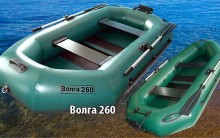
Rowing inflatable boats
Such boats, as a rule, are small in size and do not provide for the possibility of installing a motor in the design. Therefore, their use on rivers with a strong current is difficult.
Criterias of choice
When choosing such inflatable watercraft, one should be guided by the following criteria:
- on which reservoirs it will be used,
- type of fabric used (PVC or rubber),
- number of seats,
- load capacity,
Models and cost
The use of the above criteria when choosing will allow you to choose a swimming facility specifically for your needs from a variety of models. Among the majority of fishermen, the following models are in great demand: "Dive", "Ivolga", "Ufimka", "Fox".
Consider their characteristics and estimated prices in the following table:
| Brand | Weight in kg | Load capacityin kg | Lengthin cm | Widthin cm | Number of passengers |
Pricein rubles |
| "Dive 1", "Dive 2" | 120240–300 | 195255 | 100110 | 12 | ||
| 120–180240–300350 | 200–220260300 | 100–105110125 | 123 | |||
| "Ufimka" | 9–18 | 120–220 | 220–285 | 105–118 | 1–2 | 3500–11500 |
| "Fox" | 9–16 | 80–270 | 170–250 | 92–110 | 1–2 | From 6500 |
Pricein rubles
How many seats are available?
Before buying, you need to decide on the number of future passengers:
- single. Designed for one person and suitable for those who are used to fishing "light". However, there is a limited amount of things that you can take with you.
- 2-seater. Suitable for both solo and pair fishing. At the same time, they have an increased carrying capacity.
- 3-seater. This option is suitable for those who are used to taking everything they need with them. Such a vessel is capable of carrying not only two or three people, but also a fairly large amount of cargo.
What to look for when buying?
Buying a boat is a serious matter, so you need to be careful and study such aspects of the product as:
- material quality,
- seam quality,
- bottom type,
- type of seats (inflatable or rigid),
- paddle material (aluminum or wood)
- warranty,
- possibility of equipping with a motor.
Rules for the care of an inflatable boat
Any inflatable small boat requires careful maintenance. Then it will last for many years and will not cause any problems (in the absence of factory defects).
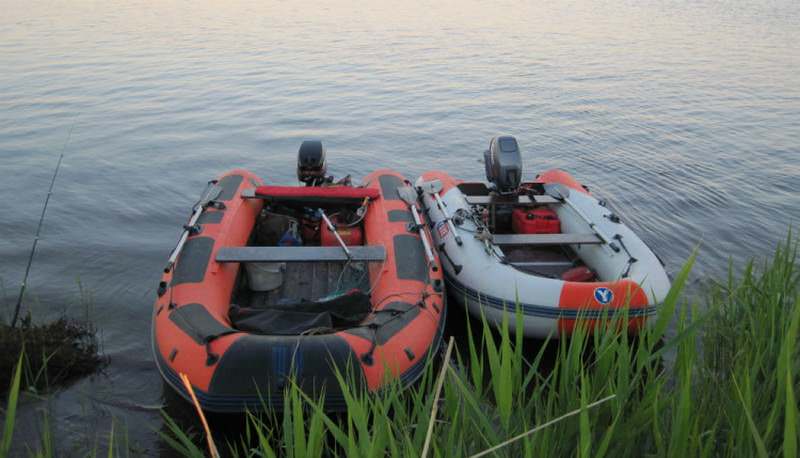 After use, the boat must be cleaned of dirt, be sure to dry
After use, the boat must be cleaned of dirt, be sure to dry When caring for him, you should adhere to the following rules:
- do not pump (otherwise there is a possibility of destruction of the seams),
- monitor in cylinders (you must adhere to the norm of 250 mbar),
- do not leave in the sun (it adversely affects the durability of the material, especially for rubber),
- do not overload
- dry well (especially rubber),
- sprinkle with talc for the winter.
- When operating, you must comply with safety standards and use life jackets.

